The Study of Mechanical Behaviors of Caprinae Horn Sheath under Pendulum Impact
Abstract
:1. Introduction
2. Materials and Methods
2.1. Materials
2.2. Charpy Pendulum Impact and Flexural Tests
2.3. High-Speed Camera Observation
2.4. Characterizations of Keratin Structure
2.5. Scanning Electron Microscopy
3. Results and Discussion
3.1. Impact Properties of Different Caprinae Horn Sheaths
3.2. Fracture Characteristics of Different Caprinae Horn Sheaths
4. Conclusions
- (1)
- All Caprinae horn sheaths could acquire a balanced dynamic mechanical property by adjusting water content. The addition of water could also reduce data dispersity of impact property with regulation of a hydrogen bonded network.
- (2)
- Correlation between β-sheet content and impact strength could be found in Caprinae horn sheath.
- (3)
- One Caprinae (White goat) horn sheath showed distinct fracture characteristics, which was supposed to correlate with the interfacial strength, leading to a various amount of delamination and 90° crack deflection energy absorption.
- (4)
- Wavy-shaped interface, scattered voids and hierarchical micro-fibre constitutes the multi-scale structure of Caprinae horn sheath, based on a fiber reinforced composite laminate model.
- (5)
- The large deformation ability of hydrated keratin gives rise to a gradual generation of micro-cracks, contributing to the toughness of Caprinae horn sheath.
Author Contributions
Funding
Institutional Review Board Statement
Informed Consent Statement
Data Availability Statement
Acknowledgments
Conflicts of Interest
References
- Lazarus, B.S.; Chadha, C.; Velasco-Hogan, A.; Barbosa, J.D.; Jasiuk, I.; Meyers, M.A. Engineering with keratin: A functional material and a source of bioinspiration. iScience 2021, 24, 102798. [Google Scholar] [CrossRef]
- Lazarus, B.S.; Velasco-Hogan, A.; Río, T.G.-D.; Meyers, M.A.; Jasiuk, I. A review of impact resistant biological and bioinspired materials and structures. J. Mater. Res. Technol. 2020, 9, 15705–15738. [Google Scholar] [CrossRef]
- Wei, H. Impact Resistant and Energy Absorbent Natural Keratin Materials: Horns and Hooves; University of California: San Diego, CA, USA, 2018; pp. 1–213. [Google Scholar]
- Packer, C. Sexual Dimorphism: The Horns of African Antelopes. Science 1983, 221, 1191–1193. [Google Scholar] [CrossRef]
- Cai, S.; Yang, K.; Xu, Y.; Guan, J.; Han, B.; Sun, B.; Zeng, Y.; Wu, S. Structure and moisture effect on the mechanical behavior of a natural biocomposite, buffalo horn sheath. Compos. Commun. 2021, 26, 100748. [Google Scholar] [CrossRef]
- Huang, W.; Restrepo, D.; Jung, J.-Y.; Su, F.Y.; Liu, Z.; Ritchie, R.O.; McKittrick, J.; Zavattieri, P.; Kisailus, D. Multiscale Toughening Mechanisms in Biological Materials and Bioinspired Designs. Adv. Mater. 2019, 31, e1901561. [Google Scholar] [CrossRef]
- Liu, Z.; Meyers, M.A.; Zhang, Z.; Ritchie, R.O. Functional gradients and heterogeneities in biological materials: Design principles, functions, and bioinspired applications. Prog. Mater. Sci. 2017, 88, 467–498. [Google Scholar] [CrossRef]
- Wang, Y.; Naleway, S.E.; Wang, B. Biological and bioinspired materials: Structure leading to functional and mechanical performance. Bioact. Mater. 2020, 5, 745–757. [Google Scholar] [CrossRef]
- Zhang, Q.; Shan, G.; Cao, P.; He, J.; Lin, Z.; Huang, Y.; Ao, N. Mechanical and biological properties of oxidized horn keratin. Mater. Sci. Eng. C 2014, 47, 123–134. [Google Scholar] [CrossRef]
- Zhang, Q.-B.; Li, C.; Pan, Y.-T.; Shan, G.-H.; Cao, P.; He, J.; Lin, Z.-S.; Ao, N.-J.; Huang, Y.-X. Microstructure and mechanical properties of horns derived from three domestic bovines. Mater. Sci. Eng. C 2013, 33, 5036–50433. [Google Scholar] [CrossRef]
- Kitchener, A.; Vincent, J.F.V. Composite theory and the effect of water on the stiffness of horn keratin. J. Mater. Sci. 1987, 22, 1385–1389. [Google Scholar] [CrossRef]
- Yin, W.; Zhang, Z.; Liu, T.; Xu, J.; Xiao, S.; Xu, Y. N-Doped Animal Keratin Waste Porous Biochar derived from Trapa Natans Husks. Materials 2020, 13, 987. [Google Scholar] [CrossRef]
- Zhang, Y.; Huang, W.; Hayashi, C.; Gatesy, J.; McKittrick, J. Microstructure and mechanical properties of different keratinous horns. J. R. Soc. Interface 2018, 15, 1742–5662. [Google Scholar] [CrossRef]
- Wang, B.; Yang, W.; McKittrick, J.; Meyers, M.A. Keratin: Structure, mechanical properties, occurrence in biological organisms, and efforts at bioinspiration. Prog. Mater. Sci. 2016, 76, 229–318. [Google Scholar] [CrossRef]
- Huang, W.; Zaheri, A.; Yang, W.; Kisailus, D.; Ritchie, R.O.; Espinosa, H.; McKittrick, J. How Water Can Affect Keratin: Hydration-Driven Recovery of Bighorn Sheep (Ovis Canadensis ) Horns. Adv. Funct. Mater. 2019, 29, 1901077. [Google Scholar] [CrossRef]
- Fuller, L.H.; Donahue, S.W. Material properties of bighorn sheep (Ovis canadensis) horncore bone with implications for energy absorption during impacts. J. Mech. Behav. Biomed. Mater. 2021, 114, 104224. [Google Scholar] [CrossRef]
- Aguirre, T.G.; Fuller, L.; Ingrole, A.; Seek, T.W.; Wheatley, B.B.; Steineman, B.D.; Donahue, T.L.H.; Donahue, S.W. Bioinspired material architectures from bighorn sheep horncore velar bone for impact loading applications. Sci. Rep. 2020, 10, 18916. [Google Scholar] [CrossRef] [PubMed]
- Huang, W.; Zaheri, A.; Jung, J.-Y.; Espinosa, H.D.; Mckittrick, J. Hierarchical structure and compressive deformation mechanisms of bighorn sheep (Ovis canadensis) horn. Acta Biomater. 2017, 64, 1–14. [Google Scholar] [CrossRef]
- Johnson, K.; Trim, M.; Francis, D.; Whittington, W.; Miller, J.; Bennett, C.; Horstemeyer, M. Moisture, anisotropy, stress state, and strain rate effects on bighorn sheep horn keratin mechanical properties. Acta Biomater. 2017, 48, 300–308. [Google Scholar] [CrossRef]
- Drake, A.; Donahue, T.L.H.; Stansloski, M.; Fox, K.; Wheatley, B.B.; Donahue, S.W. Horn and horn core trabecular bone of bighorn sheep rams absorbs impact energy and reduces brain cavity accelerations during high impact ramming of the skull. Acta Biomater. 2016, 44, 41–50. [Google Scholar] [CrossRef]
- Tombolato, L.; Novitskaya, E.E.; Chen, P.-Y.; Sheppard, F.A.; McKittrick, J. Microstructure, elastic properties and deformation mechanisms of horn keratin. Acta Biomater. 2010, 6, 319–330. [Google Scholar] [CrossRef]
- Kassar, S.; Siblini, S.; Wehbi, B.; Abro, O.; Shehadeh, M. Towards A Safer Design of Helmets: Finite Element and Experimental Assessment; ASME International Mechanincal Engineering Congress and Exposition: Phoenix, AZ, USA, 2016. [Google Scholar]
- Ingrole, A.; Aguirre, T.G.; Fuller, L.; Donahue, S.W. Bioinspired energy absorbing material designs using additive manufacturing. J. Mech. Behav. Biomed. Mater. 2021, 119, 104518. [Google Scholar] [CrossRef]
- Xu, J.; Li, Y.; Fu, K. Impact Resistance of Horn-Inspired Tubular Composite Structure. Acta Mater. Com. Sinica. 2022, 40, 1–12. [Google Scholar]
- Liu, S.; Xu, S.; Song, J.; Zhou, J.; Xu, L.; Li, X.; Zou, M. Mechanical Properties and Failure Deformation Mechanisms of Yak Horn Under Quasi-Static Compression and Dynamic Impact. J. Mech. Behav. Biomed. 2020, 107, 103753. [Google Scholar] [CrossRef]
- Shi, X.; Wang, Y.; Jia, R.; Liu, F.; Zhang, J. Experimental Investigations on Microstructures and Mechanical Properties of White Yak Horns Sheath. Results Phys. 2019, 13, 102174. [Google Scholar] [CrossRef]
- Zhou, J.; Liu, S.; Guo, Z.; Xu, S.; Song, J.; Zou, M. Study on the energy absorption performance of bionic tube inspired by yak horn. Mech. Adv. Mater. Struct. 2021, 2, 1–13. [Google Scholar] [CrossRef]
- Li, B.-W.; Zhao, H.-P.; Feng, X.-Q. Static and dynamic mechanical properties of cattle horns. Mater. Sci. Eng. C 2011, 31, 179–183. [Google Scholar] [CrossRef]
- Li, B.W.; Zhao, H.P.; Feng, X.-Q.; Guo, W.W.; Shan, S. Experimental study on the mechanical properties of the horn sheaths from cattle. J. Exp. Biol. 2010, 213, 479–486. [Google Scholar] [CrossRef]
- Zhu, B.; Zhang, M.; Zhao, J. Microstructure and mechanical properties of sheep horn. Microsc. Res. Tech. 2016, 79, 664–674. [Google Scholar] [CrossRef]
- Mysore, T.; Patil, A.; Raju, G.; Banapurmath, N.; Bhovi, P.; Afzal, A.; Alamri, S.; Saleel, C. Investigation of Mechanical and Physical Properties of Big Sheep Horn as an Alternative Biomaterial for Structural Applications. Materials 2021, 14, 4039. [Google Scholar] [CrossRef]
- Zhou, P.; Pan, Y.-T.; Wang, Z.; He, C.-L.; Huang, Y.-X. Raman and surface-enhanced Raman spectroscopy on horns and their correlation with biomechanical properties. J. Raman Spectrosc. 2016, 47, 926–932. [Google Scholar] [CrossRef]
- McKittrick, J.; Chen, P.-Y.; Bodde, S.G.; Yang, W.; Novitskaya, E.E.; Meyers, M.A. The Structure, Functions, and Mechanical Properties of Keratin. JOM 2012, 64, 449–468. [Google Scholar] [CrossRef]
- Shah, D.U.; Porter, D.; Vollrath, F. Can silk become an effective reinforcing fibre? A property comparison with flax and glass reinforced composites. Compos. Sci. Technol. 2014, 101, 173–183. [Google Scholar] [CrossRef]
- Huang, W.Y.; Araghi, N.A.; Yang, W.; Velazquez-Olivera, A.; Li, Z.; Ritchiem, R.O.; Kisailus, D.; Stover, S.M.; Mckittrick, J. A Natural Energy Absorbent Polymer Composite: The Equine Hoof Wall. Acta Biomater. 2019, 90, 267–277. [Google Scholar] [CrossRef] [PubMed]


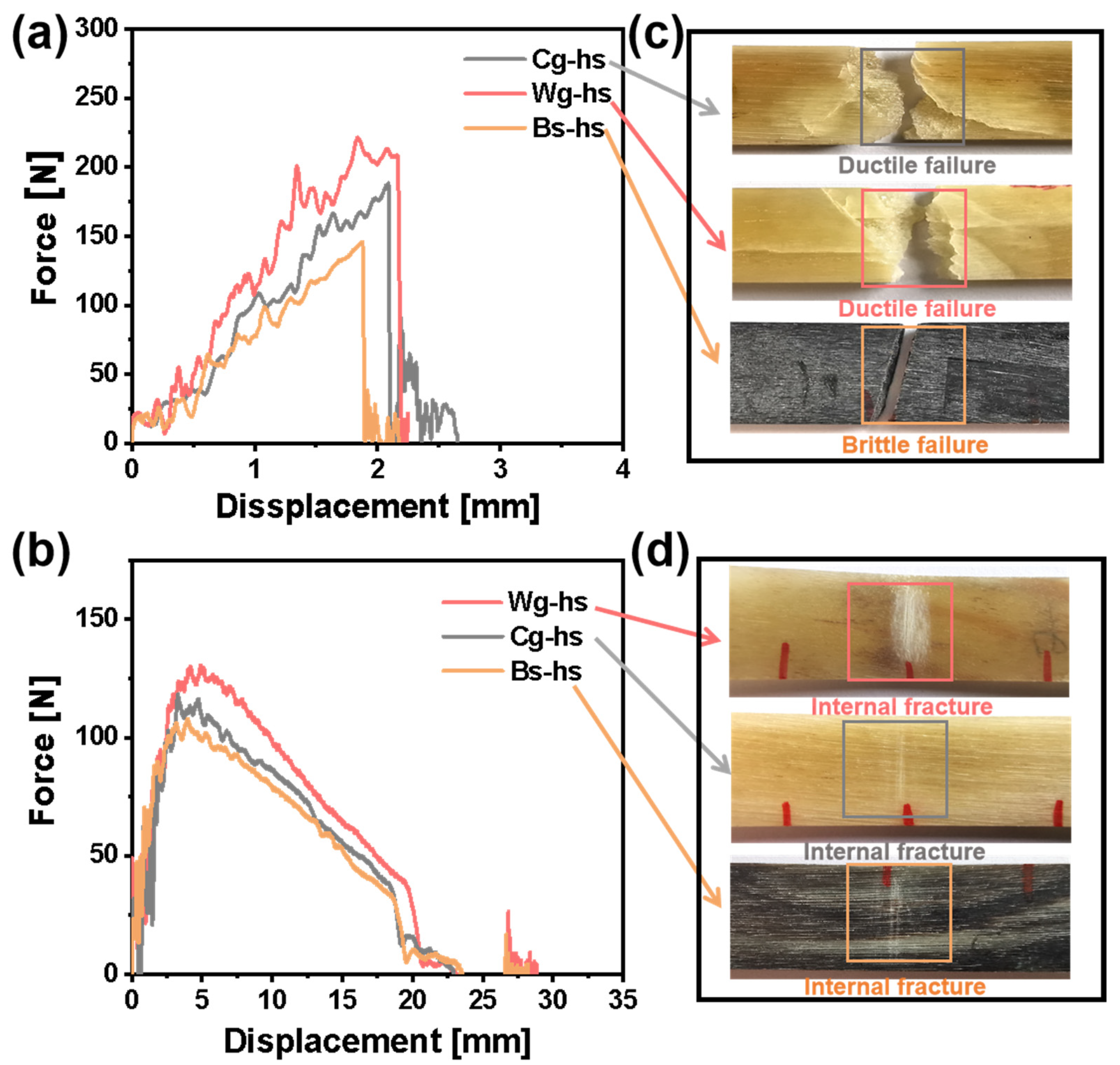
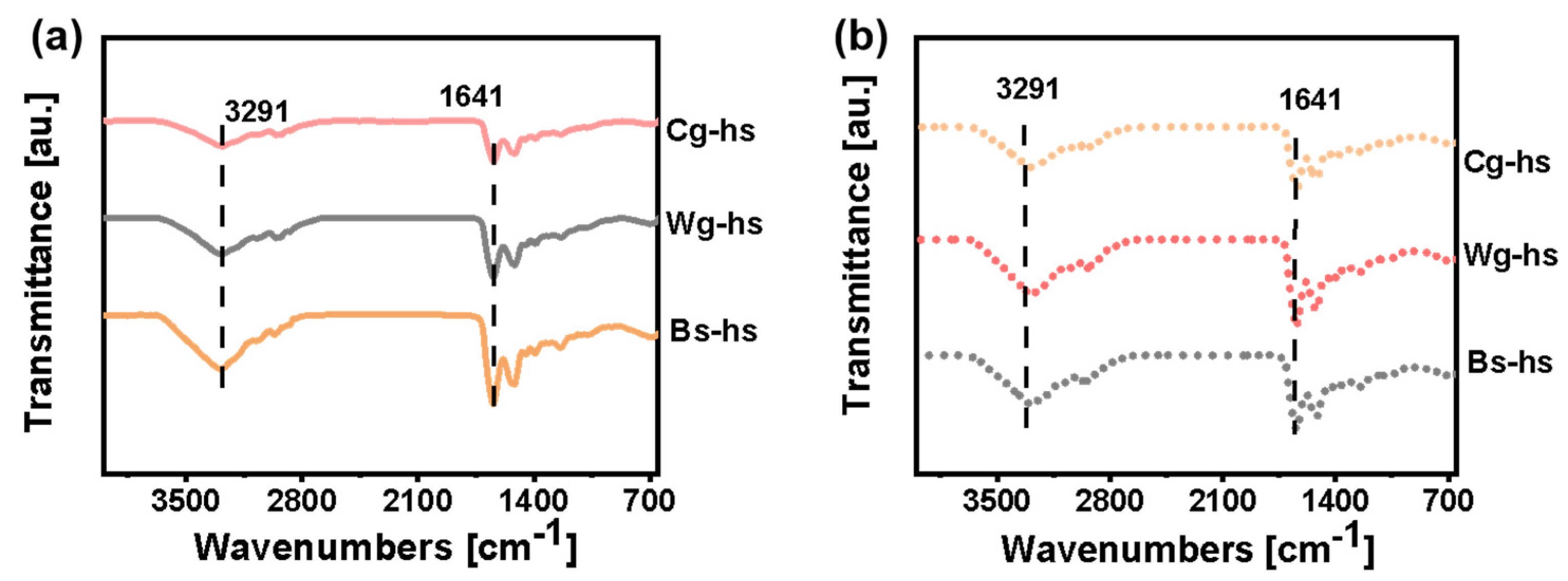
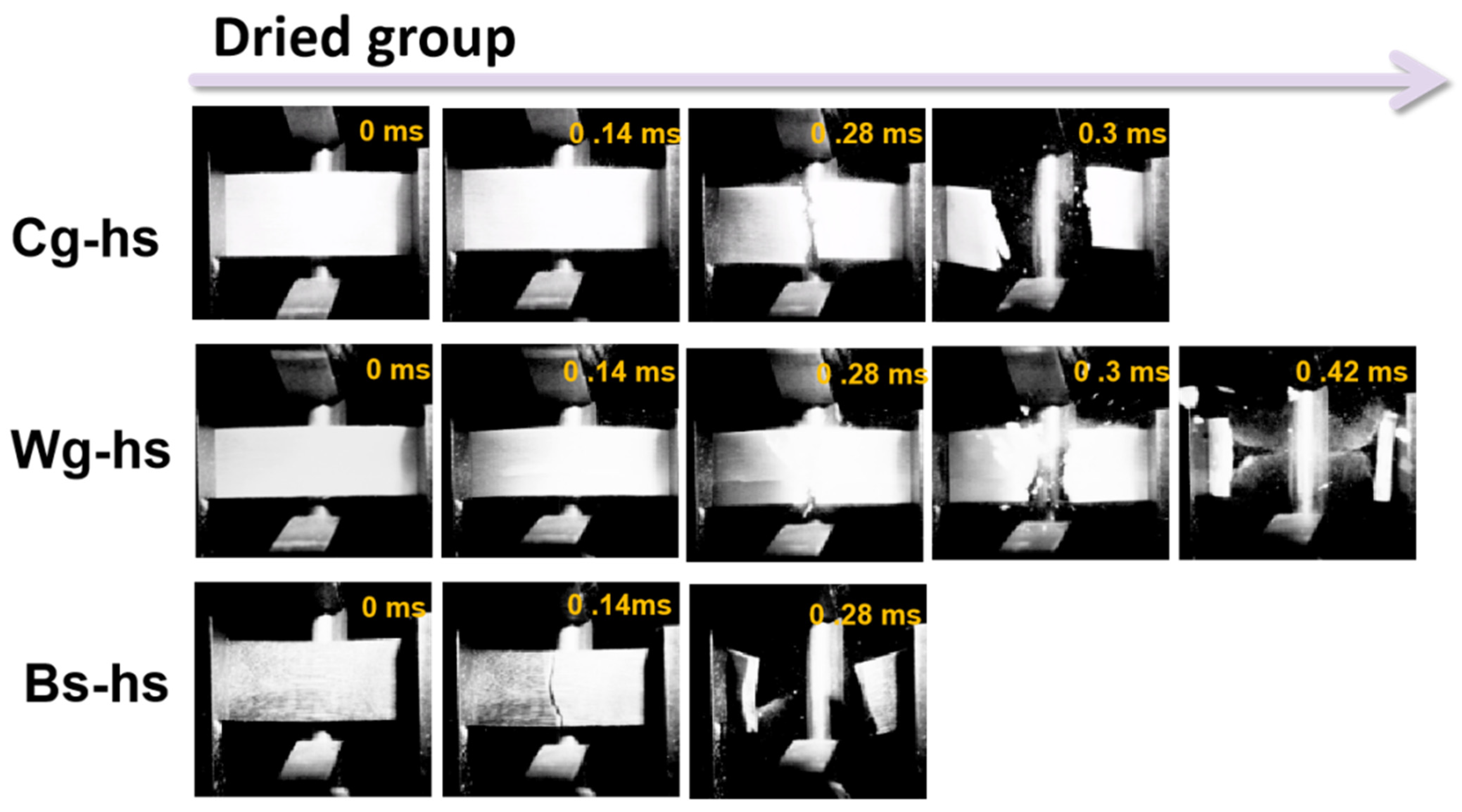

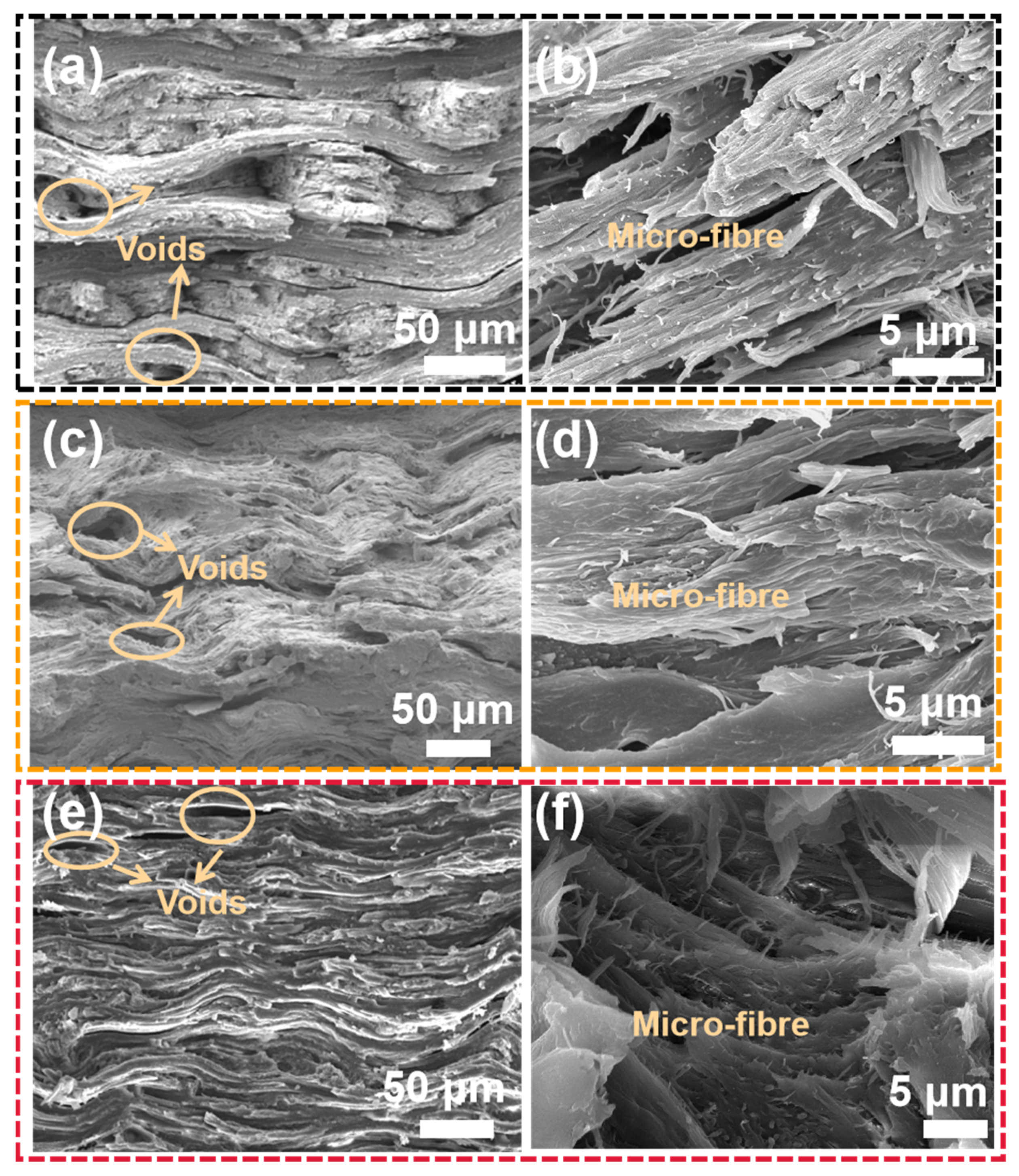
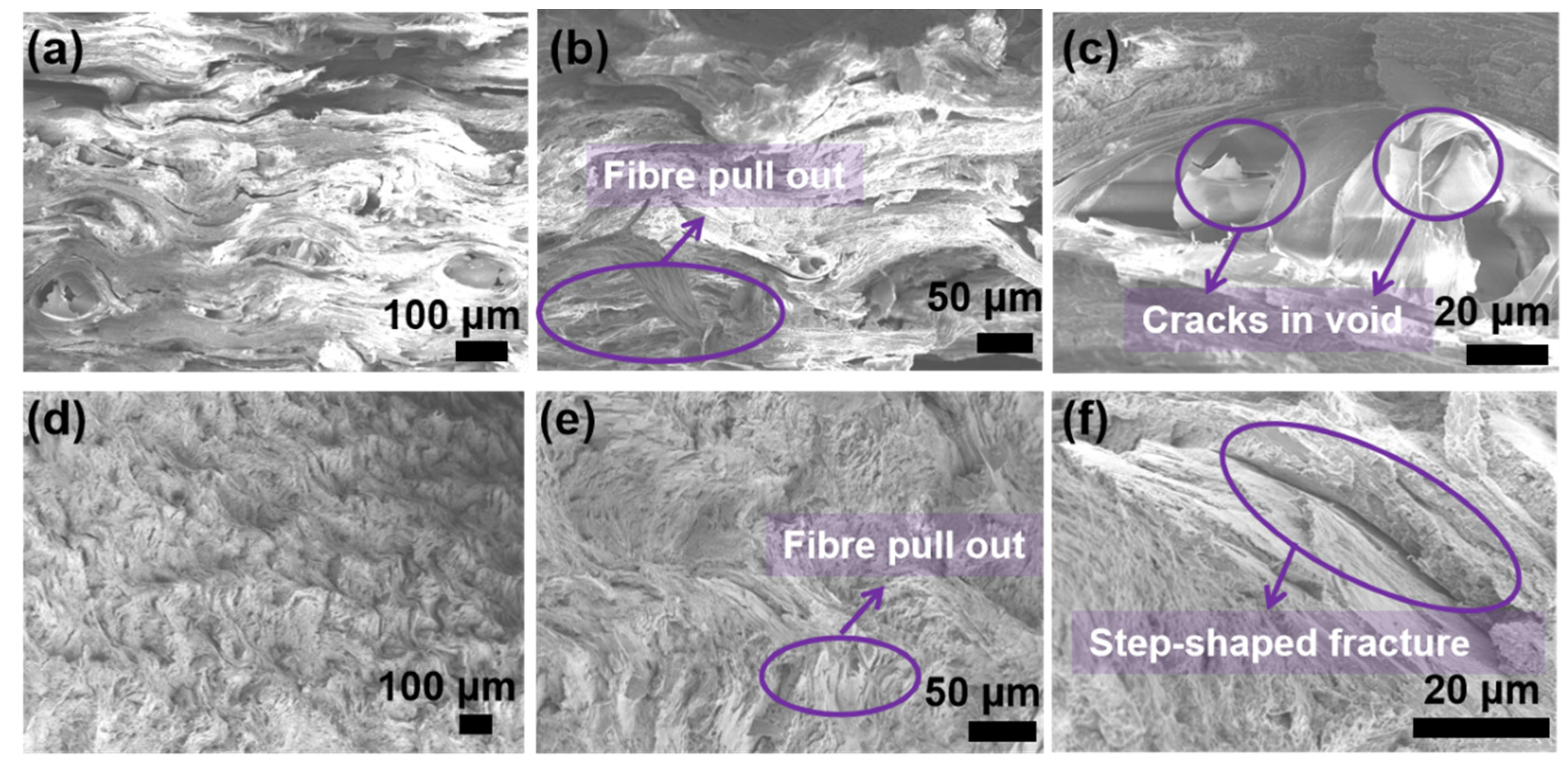

| Sample | Weight | Sample | Weight | Weight Uptake |
|---|---|---|---|---|
| Dried Cg-hs | 1.31 ± 0.02 | Hydrated Cg-hs | 1.59 ± 0.03 | ~0.28 |
| Dried Wg-hs | 1.35 ± 0.03 | Hydrated Wg-hs | 1.62 ± 0.02 | ~0.27 |
| Dried Bs-hs | 1.30 ± 0.03 | Hydrated Bg-hs | 1.57 ± 0.13 | ~0.27 |
| Sample | Secondary Structure | Element | ||||
|---|---|---|---|---|---|---|
| α-Helix (%) | β-Sheet (%) | C (%) | N (%) | O (%) | S (%) | |
| Dried Cg-hs | 14.9 | 30.2 | 55.41 ± 5.4 | 16.05 ± 4.61 | 25.21 ± 4.9 | 3.32 ± 2.33 |
| Dried Wg-hs | 13.5 | 40.2 | 58.56 ± 7.40 | 11.47 ± 5.00 | 24.36 ± 7.62 | 5.61 ± 4.18 |
| Dried Bs-hs | 14.9 | 30.4 | 56.60 ± 10.16 | 12.78 ± 7.83 | 25.80 ± 4.82 | 4.83 ± 3.43 |
| Hydrated Cg-hs | 14.4 | 32.4 | - | - | - | - |
| Hydrated Wg-hs | 15.0 | 29.9 | - | - | - | - |
| Hydrated Bs-hs | 14.9 | 30.4 | - | - | - | - |
| Sample | Elastic Modulus [GPa] | Flexual Strength [MPa] |
|---|---|---|
| Dried Cg-hs | 3.13 ± 0.09 | 181.79 ± 23.17 |
| Dried Wg-hs | 3.29 ± 0.07 | 244.66 ± 36.87 |
| Dried Bs-hs | 3.03 ± 0.2 | 164.69 ± 15.22 |
| Hydrated Cg-hs | 2.71 ± 0.08 | 77.74 ± 4.83 |
| Hydrated Wg-hs | 2.09 ± 0.03 | 83.20 ± 21.02 |
| Hydrated Bs-hs | 1.47 ± 0.01 | 82.38 ± 7.15 |
Publisher’s Note: MDPI stays neutral with regard to jurisdictional claims in published maps and institutional affiliations. |
© 2022 by the authors. Licensee MDPI, Basel, Switzerland. This article is an open access article distributed under the terms and conditions of the Creative Commons Attribution (CC BY) license (https://creativecommons.org/licenses/by/4.0/).
Share and Cite
Yang, K.; Qin, N.; Zhou, C.; Wang, B.; Yu, H.; Li, H.; Yu, H.; Deng, H. The Study of Mechanical Behaviors of Caprinae Horn Sheath under Pendulum Impact. Polymers 2022, 14, 3272. https://doi.org/10.3390/polym14163272
Yang K, Qin N, Zhou C, Wang B, Yu H, Li H, Yu H, Deng H. The Study of Mechanical Behaviors of Caprinae Horn Sheath under Pendulum Impact. Polymers. 2022; 14(16):3272. https://doi.org/10.3390/polym14163272
Chicago/Turabian StyleYang, Kang, Nannan Qin, Changgeng Zhou, Bing Wang, Haotian Yu, Haotong Li, Haiyun Yu, and Hailiang Deng. 2022. "The Study of Mechanical Behaviors of Caprinae Horn Sheath under Pendulum Impact" Polymers 14, no. 16: 3272. https://doi.org/10.3390/polym14163272
APA StyleYang, K., Qin, N., Zhou, C., Wang, B., Yu, H., Li, H., Yu, H., & Deng, H. (2022). The Study of Mechanical Behaviors of Caprinae Horn Sheath under Pendulum Impact. Polymers, 14(16), 3272. https://doi.org/10.3390/polym14163272





